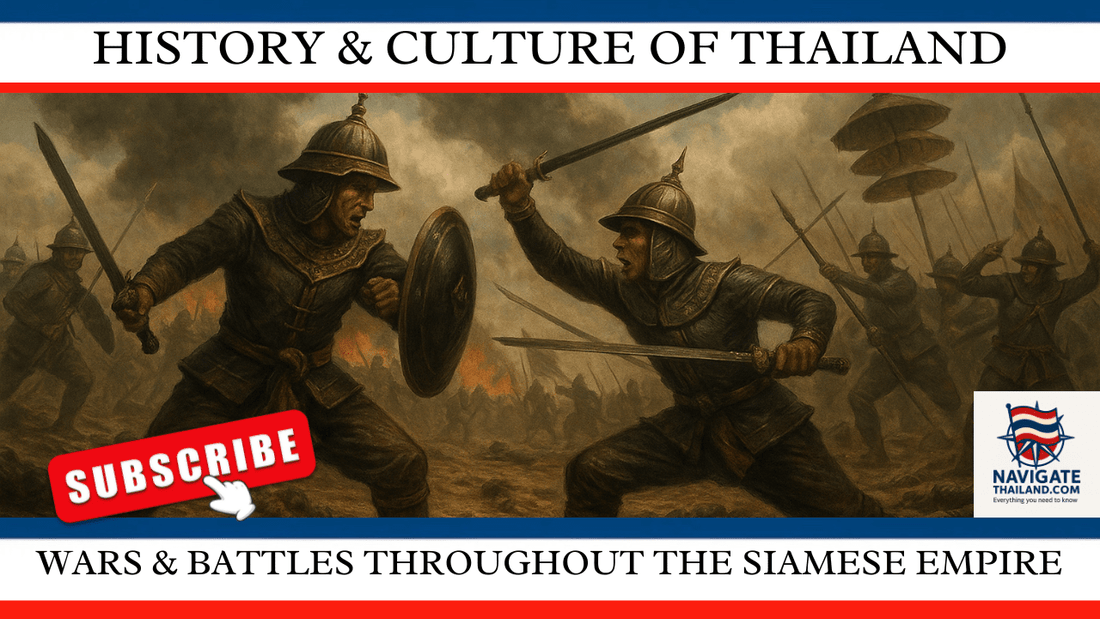
The History of Wars and Battles Throughout the Siamese Empire
Share
The history of the Siamese Empire, now known as Thailand, spans centuries of warfare, territorial disputes, and political struggles. From tribal conflicts to the rise of the Sukhothai and Ayutthaya kingdoms, the Thai people mastered unique strategies and technologies—war elephants, advanced weaponry, and combat techniques—that helped them secure their place in Southeast Asia.
Early Tribal Conflicts and the Dvaravati Period
Timeframe: 6th to 11th Century
Key Battles:
• Dvaravati Kingdom’s Conflicts
The Mon-dominated Dvaravati Kingdom was centered in central Thailand. Although records are scarce, conflicts with neighboring Khmer and Tai tribes for agricultural land and trade routes were likely.
Outcome: The Dvaravati Kingdom was eventually absorbed by the Khmer Empire in the 11th century.
The Rise of the Sukhothai Kingdom
Timeframe: 1238–1438
Key Battles:
• Revolt Against the Khmer Empire (1238)
The Sukhothai Kingdom began with a successful revolt led by local leaders, marking the rise of a distinct Thai identity.
Weapons & Tactics: Sukhothai armies used traditional weapons and relied heavily on war elephants.
The Ayutthaya Kingdom: A Military Powerhouse
Timeframe: 1351–1767
Ayutthaya, founded by King Uthong, became one of Southeast Asia’s most powerful kingdoms.
Key Battles:
• First Burmese–Siamese War (1548–1549)
The Burmese Taungoo Dynasty’s invasion was repelled by Ayutthaya, solidifying its defensive strategies.
Weapons & Tactics: Infantry, war elephants, and cannons—often from Portuguese designs—were used to great effect.
• Naresuan’s Rebellion (1584–1593)
Naresuan secured Ayutthaya’s independence with a famous elephant duel against the Burmese crown prince.
The Fall of Ayutthaya and Rise of the Thonburi Kingdom
Timeframe: 1767–1782
After Ayutthaya fell in 1767, General Taksin led a resistance, establishing a new capital in Thonburi and reunifying the kingdom.
Key Battles:
• Campaigns Against Burmese Forces
Taksin’s strategies, including swift cavalry raids, were crucial in reestablishing Thai independence.
The Rattanakosin Kingdom (Bangkok Era)
Timeframe: 1782–present
Founded by King Rama I, the Rattanakosin Kingdom marked the beginning of modern Thailand. It retained independence while other Southeast Asian nations fell under colonial rule, largely thanks to skilled diplomacy by leaders like King Chulalongkorn.
Key Battles:
• Siamese–Vietnamese Wars (1785–1845)
A series of conflicts over Cambodia and Laos marked Thailand’s regional struggles for influence.
Outcome: The wars were largely inconclusive, with Siam and Vietnam gaining and losing territories over the years.
• Siamese–Franco War (1893)
Conflict with France over Laos during King Chulalongkorn’s reign resulted in Siam ceding Laos to French Indochina, though Thailand remained independent.
Tribal Wars and Internal Conflicts
Various ethnic groups, such as the Hmong, Karen, and Isaan peoples, sometimes clashed with Thai central authorities over autonomy and resources. These conflicts were often characterized by guerrilla tactics, especially in mountainous regions.
Key Battles:
• Hmong and Karen Uprisings (19th Century)
Ethnic groups like the Hmong and Karen resisted centralization efforts, leading to frequent uprisings.
Outcome: Most uprisings were suppressed, though these groups retained some autonomy.
Battle Tactics and Weaponry Throughout Thai History
Across different historical periods, the Siamese empire utilized a range of battle strategies and weapons.
• War Elephants: Elephants played a critical role in the military, especially in Ayutthaya and early Rattanakosin periods, used to break enemy lines and for ceremonial purposes.
• Swords and Spears: Traditional weapons, like the Thai sword (krabi) and spear, were widely used by infantry soldiers.
• Muay Boran: Muay Boran was developed as a form of hand-to-hand combat, especially useful in guerrilla warfare and close combat situations.
• Firearms and Cannons: Firearms introduced by the Portuguese in the 16th century became central to Siamese warfare, especially by the Rattanakosin Kingdom.
• Diplomatic Tactics: Leaders, particularly King Chulalongkorn, used diplomacy to maintain Siam’s independence during the European colonial era.
Fun Historical and Cultural Facts
• King Naresuan’s Elephant Duel: The legendary elephant duel between King Naresuan and the Burmese crown prince is still reenacted in Thai festivals and ceremonies today.
• Songkran Festival and Warfare: Songkran’s traditional water rituals trace back to blessings for soldiers, which evolved into the modern water fights celebrated during the Thai New Year.
• Fortifications of Ayutthaya: The impressive city walls of Ayutthaya were instrumental in defending against Burmese invasions, though the city eventually fell in 1767.
Conclusion
The history of wars throughout the Siamese Empire showcases resilience, diplomatic skill, and military innovation. From early tribal conflicts to the powerful Ayutthaya and Rattanakosin Kingdoms, Thailand’s history is a testament to its unique place in Southeast Asia. These battles and strategies continue to influence Thai culture today, celebrated in festivals, historical reenactments, and national monuments.
- Introduction & Early Tribal Conflicts
• Baker, C., & Phongpaichit, P. (2005). A History of Thailand. Cambridge University Press.
Details on the early formation of Thai identity and interactions with neighboring states; mentions of Dvaravati and Khmer influence.
2. The Sukhothai Kingdom
• Wyatt, D. K. (1984). Thailand: A Short History. Yale University Press.
Covers the establishment of Sukhothai, its revolt against Khmer control, and Sukhothai’s role in developing a distinct Thai culture.
3. The Ayutthaya Kingdom and Burmese Conflicts
• SarDesai, D. R. (2012). Southeast Asia: Past and Present. Westview Press.
Provides an overview of Ayutthaya’s military structure, early Burmese wars, and the reign of King Naresuan, including his famous elephant duel.
4. The Fall of Ayutthaya & the Rise of Thonburi
• Tarling, N. (Ed.). (1999). The Cambridge History of Southeast Asia. Cambridge University Press.
Details Ayutthaya’s eventual fall to Burma and Taksin’s efforts to reunify the kingdom, establishing Thonburi.
5. The Rattanakosin Kingdom and Diplomatic Tactics
• Van Roy, E. (2018). Siamese Melting Pot: Ethnic Minorities in the Making of Bangkok. ISEAS-Yusof Ishak Institute.
Covers the consolidation of Rattanakosin, the regional power struggles with Vietnam, and King Chulalongkorn’s successful diplomatic strategies to maintain independence.
6. Tribal Wars and Internal Conflicts
• Wood, W. A. R. (1924). A History of Siam. Chaperone.
Describes the regional tensions with various ethnic groups such as the Hmong and Karen and their conflicts over autonomy and centralization.
7. Battle Tactics and Weaponry in Thai Warfare
• Vickery, M. (1979). Cambodia after Angkor: The Chronicular Evidence for the Fourteenth to Sixteenth Centuries. Journal of Southeast Asian Studies.
Mentions early Siamese military practices, the role of elephants, Muay Boran’s origin as a martial art for self-defense, and the adoption of Portuguese firearms.
Read more of our Thailand blog series:
Thai Food Guide:Traditional Recipes and Street Eats
Everything Travellers Need to know
Thailand travel ebooks and language guides
Thailand Travel Apparel & Souvenir Gifts
Subscribe to our YouTube channel Navigate Thailand to see our most popular Thailand travel blogs turned into videos:
Navigate Thailand YouTube channel










































































































































